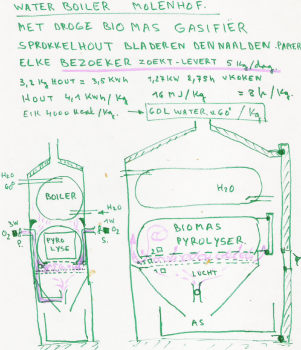I learned to make TLUDs from Dr. Paul Anderson when he came to do a stove & biochar demonstration for Biochar Ontario in June 2009. Since my primary interest was in producing biochar, I went home and began building a larger version of the “Champion” TLUD stove from a 55 gallon drum and a 25 gallon drum (pictured above.) I have been following this list since then and on “Dr. TLUD’s” urging, I thought should begin sharing with this community what I have been learning.
The “Large TLUD”
Essentially a "beefed up" version of the Champion TLUD Stove, my large TLUD has worked beautifully from the first trial run. The pyrolysis process is extremely clean in terms of visible emissions and can produce 25 – 30 liters (6 – 8 gallons) of biochar per run depending on feedstock. To halt the pyrolysis process to retain the biochar I have always used a watering can to quench the glowing coals. Two to four gallons of water usually does the trick.
Using this stove, I have pyrolyzed a number of different types of feedstock including: scraps of spruce lumber, pine needles, pine cones, pine bark, corn cobs, chicken litter, and hardwood sawdust pellets. The successful pyrolysis of the various feedstock has always depended on (no surprise here) having dry feedstock with pyrolysis times ranging from one to two + hours (again, depending on feedstock.)
Until recently I had been using a hardware store woodstove thermometer on the top of the stove.
I estimated pyroloysis temperatures to be in the 350-450 C range. I began using a 12vdc computer cooling fan to shorten run times and boost temperatures closer to 500 C. I recently acquired a temperature data logger and found, to my surprise, that temperature quickly shot to over 800 C with the fan. Even without the fan, temperatures in and above the pyrolysis front were between 600 and 750 C. The data from the first run with the data logger is attached. *Note:T1 is the thermocouple near the top of the inner fuel barrel just below the top of the feedstck and T2 is the thermocouple about 2 inches above the bottom of the inner fuel barrel.
My next steps are to monitor temperatures while experimenting with choking the primary air to different degrees and as I gain better control of pyrolysis temperatures, to (further) experiment with various types of feedstock. I am also working on a simple system to use the pyrolysis heat to dry feedstock.
I will post my results here.


